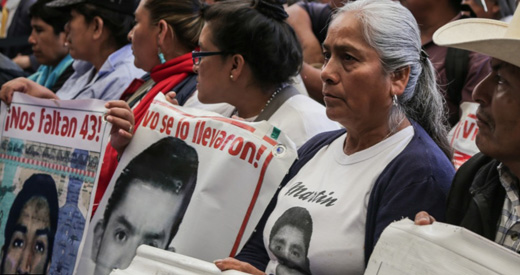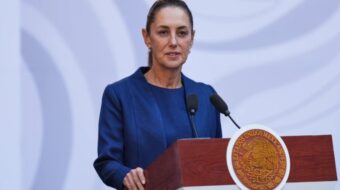
An international team of forensics experts which has been looking into the September 2014 disappearance of 43 students at a rural teacher training college has finished its work. In its final report, it not only blasted the government of Mexican President Enrique Peña Nieto for interfering with its work, but also raised serious new questions about the involvement of federal authorities in the disappearance of the students.
The students were part of a group from the Raul Isidro Burgos Normal School in Ayotzinapa, near the small city of Iguala in Mexico’s strife-torn Southern state of Guerrero. They had gone to Iguala to raise money for their school, and commandeered several buses to take them back to their school. Such actions are a common practice in Mexico, where they are seen as a protest tactic and not as robbery or terrorism.
However, the students were not allowed to leave Iguala, but were stopped by local police, who opened fire on the buses, killing students, bystanders who were stuck in the traffic jam caused by the police blockade, and people who arrived for a press conference to protest the killing. Forty three students were taken away in official vehicles, and have not been seen since.
For a year and a half, while protests involving hundreds of thousands of people have taken place throughout Mexico behind the slogan “they were taken away alive, we want them back alive”, the Mexican government has stalled and maneuvered to evade responsibility for the action. Mexico’s Attorney General at the time, Jesus Murillo Karam (who has since resigned) stuck to a story that corrupt local police in Iguala had kidnapped the students and taken them to a town dump outside the neighboring community of Cocula, where they were killed, their bodies burned and the remains thrown into a nearby river.
From the start, the families of the students, mostly poor indigenous farmers, and much of public opinion in Mexico has been skeptical, to say the least, about this version of events, which appears to be designed to deflect all responsibility from the federal government to the local officials in Iguala, who are accused to be in league with a drug-dealing gang, United Warriors, who wanted the students killed.
Summary of story: http://fusion.net/story/295298/final-report-on-ayotzinapa-killings-suggests-cover-up-and-forced-confessions/
The full report of the Interdisciplinary Group of Independent Experts (Grupo Interdisciplinario de Expertos Independientes, or GIEI) is 604 pages long. But the members of the group consider it incomplete because of lack of cooperation from the Mexican government.
The panel of five experts, which include the well-known former attorney general of Guatemala, Claudia Paz y Paz, who was instrumental in bringing charges against that country’s former dictator, General Efrain Rios Montt, and other experts from Spain, Chile and Colombia, was working under the auspices of the Inter-American Commission on Human Rights, and supposedly had the full authorization and cooperation of the Mexican government. But this cooperation broke down toward the end, according to GIEI members, when it became clear that the investigation’s result was going to contradict the government’s version, or what former attorney general Murillo Karam had referred to as the “historical truth” about the incident in Iguala.
Among the discrepancies:
*The GIEI concluded that there is no real evidence that the students’ bodies were burned in the dump at Cucula, a conclusion which others have reached also. Disposal by burning of so many human bodies would have required a large amount of fuel and would have created a huge plume of smoke and other things that were not found to have occurred.
*Mexican authorities so mishandled the evidence at the Cocula site that it could easily have been manipulated to reinforce the government’s story. Such is alleged by Alvaro Delgado in the Mexican online magazine Proceso, who accused a close advisor of President Peña Nieto, Tomas Zeron de Lucio, an official of the ministry of justice, of personal involvement in tampering with the evidence at Cocula. The GIEI suggests that his physical presence at the Cocula dump may be a cause for suspicion of this.
*A key part of the government’s claim of only local involvement in the crime consisted of confessions from corrupt police officers and members of the United Warriors gang. But GIEI found very strong evidence that some of these confessions, in the cases of at least 17 arrested persons, had been extracted by torture. Not only did accused persons tell the GIEI this, but there was evidence of injuries to their bodies which backed up the story.
The GIEI members also complained that a smear campaign had been unleashed against them in sectors of the Mexican press and media that support President Peña Nieto’s party, the PRI (Revolutionary Institutional Party). The team was accused of overcharging for its services, and Ms. Paz y Paz was red-baited.
Argentine and Austrian experts have also looked into the Ayotzinapa case and have not been able to confirm the government’s version.
One possibility is that one of the buses which the students had unwittingly commandeered was being used to transport drugs from Guerrero to the United States, so the people involved with the drug dealing were desperate to get it back under their control. Evidence for that, according to GIEI, is the apparent disappearance of the driver of that bus and his substitution by another individual put forward by the authorities.
But if, as the report indicates, federal authorities did engage in a cover-up, this may have served other political goals as well. The group of teacher training colleges, called Rural Normal Schools, of which the Ayotzinapa school is a part, were set up in the 1920s and supported by left-wing President Lazaro Cardenas’ administration in the 1930s, to close the educational gap of poor rural communities in Mexico’s heartland. They have, since then, been hotbeds of radical politics, and currently in Guerrero there are conflicts between the government and a radical dissident faction of the teachers’ union. The Rural Normal Schools are part of the resistance to supposed “educational reforms” that Peña Nieto’s government is promoting. Historically, the PRI does not respond well to that kind of resistance.
Photo: Amnesty.org










